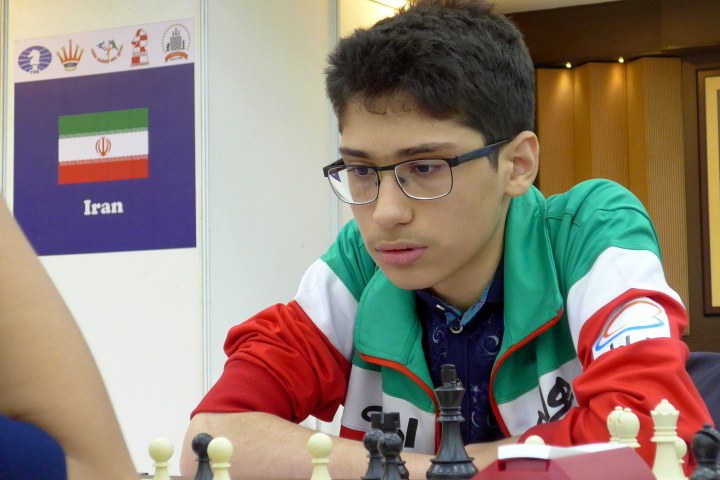


Here's a story of a young player who is not yet well known since he does not run a Twitter account or have his own homepage. Our protagonist already won the Iranian national championship at the age of 12 and played in a chess Olympiad in 2016. Last week he was the top scorer at the World Youth Under-16 Olympiad, where he posted a 2736 performance rating. His playing style is clearly tactically oriented and his calculating skill recalls to mind one of the greatest chess players of all time: Mikhail Tal.
In April 2018, Alireza Firouzja met the last requirement for the Grandmaster title. He earned all his GM-norms within a year (two Aeroflot Open A group, 2017 and 2018, and one in the Abu Dhabi Open 2017). Born in Babol, in northern Iran, on June 18th, 2003 the 15-year-old is the current number one rated player under-16 with a current Elo 2607. The proximity of his birthplace to the Caspian Sea is something he has in common with a former young talent who turned 55 this year.
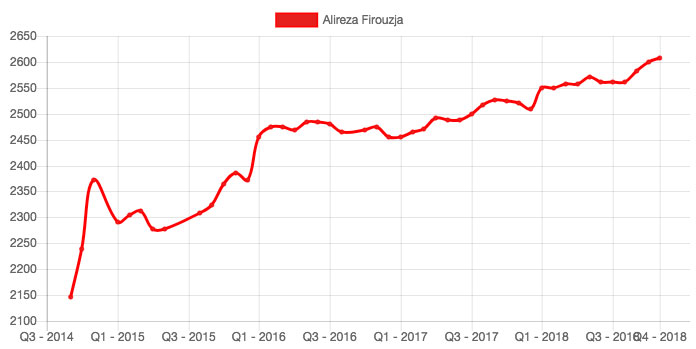
Firouzja's rating progression | players.chessbase.com
In the rest of the world, Alireza is not as well known as the two Indian prodigies Pragg and Nihal. This is probably due to the fact that the Iranian currently seems to be able to play only in countries that are friendly or neutral towards Iran such as Russia, the UAE and Qatar. [For instance, he was unable to obtain a visa for the USA to attend the 2017 Match of the Millennials -Ed.] At the moment, given the general political climate, it does not look as if this will change in the near future. So far, his foreign travel has been limited to official youth championships. Nevertheless, he has already played against plenty of strong opposition.
One would think that a player from Iran without access to the western tournament circuit might be lacking in opportunities to play, stunting his progress. But so far, that doesn't seem to have held him back: In 2016, FIDE shows 121 rated classical games for the young Iranian, 92 games in 2017 and already 127 to-date in 2018.
The first recorded game of Alireza can be found in 2013 at the Under-10 World Youth Championship in the United Arab Emirates. At that time, his repertoire against the main 1.e4 and 1.d4 consisted of French and Benoni. Compared to today's repertoire, at least the French seems rather unusual. Nowadays you have to expect Najdorf more, which is also more suited to Alireza's tactical skills.
Here is Firouzja speaking with WIM Fiona Steil-Antoni almost three years ago at the 2015 Qatar Masters Open.
The breakthrough year for Firouzja was 2016. He managed his IM title this year and won the national championship, which was quite an achievement for such a young player despite the tournament being relatively weak that year.
He played for the Iranian national team in the Asian team championship, scored the best result on board 4 and then followed up with his first appearance in a Chess Olympiad in Baku.
In January, Alireza scored 6 out of 9 at the Kazar Cup in Rasht in Iran against a 2396 resistance. At the Aeroflot A-Open, he scored his first GM norm with 6 out of 9 against 2621-average rated opposition — the first real exclamation point of his professional career with a performance rating of 2766.
A brief pause followed: First, a small disappointment in the Iranian national championship with 4 out of 11. Then Alireza played in Dubai scoring just 4½ out of 8. The tournament in Abu Dhabi was next. There he managed to beat three grandmasters in a row in rounds 4 to 6, and finished with a performance was 2644, for another GM norm.
He closed out the year with 8 out of 9 at the Under-16 World Team Championship in India. For a tournament with a rating average of 2350, this was not a bad end of the year. He won a game against another familiar child prodigy: Praggnanandhaa.
IM Sagar Shah documents the start of Praggnanadhaa against Firouzja from last year's World Youth Olympiad. Perhaps we can look forward to higher-profile battles between these two in the future:
This year also started well as Firouzja qualified for the national championship, the so-called semi-final. He scored 7½ out of 9 games in against opposition rated 2397. The result is actually enough for a GM norm. However, he had only two grandmasters as opponents, so this wasn't enough for a norm, although his performance was 2678.
The third and final norm came in Moscow: at the Aeroflot A-Open, where just 50 per cent was enough against 2635-rated opposition. Firouzja played against nine grandmasters and won two games practically on-demand, following a defeat. This shows nerve and willpower. Previously, Alireza played at the 26th International Fajr Festival (Oxin Cup) in the northern Iranian city of Amo: In the master group, he earned 6½ out of nine rounds. The 2453-average opposition resulted in a performance of 2640. However, he played against six compatriots there, which does not meet the rules for international titles. In any case, the young Iranian achieved three GM standard results at the beginning of the year.
After this Firouzja once again played the Iranian national championship and this time scored 7 out of 11 against opponents with a 2479-average rating for a performance of 2581, finishing in third place.
In online play, he attracted the attention of none other than World Champion Magnus Carlsen. Carlsen naturally had the upper hand in a string of bullet games, but he clearly respects this up and comer.
The pair played five more games that evening: Game 1, Game 2, Game 3, Game 4, Game 5
I have not come up with a better word than uncompromising. The Iranian does not shy away from a fight and revels in tactical skirmishes. It may sound a bit exaggerated to compare it to the Magician from Riga, but watch some of his games, and you're guaranteed to be enamoured.
In order to reach "his" positions, Alireza occasionally plays slightly dubious variations and unlike the two Indian young talents Pragg, and Nihal, he does not like to exchange pieces. His percentage of decisive games is also higher.
Firouzja is a late starter and often takes a round or two to find his feet. He lost his first two games at the Iranian championship in 2018 and yet finished the tournament with a good 7 out of 11.
But setting aside all the statistics and descriptions of this chess talent from Iran, the selection of annotated games and fragments should provide an impression of his style of play. Maybe Alireza still has slight positional weaknesses, but he compensates for this in many games with his tactical skills, which are likely to continue driving his grandmasters victims to despair. His opening repertoire is also tailored to his playing style.
Translation from German: Macauley Peterson and Johannes Fischer
Ivan Sokolov is a well known Dutch grandmaster and coach. In the last two years, he has been working with the Iranian team and has helped develop young Iranian talents. In this interview with IM Sagar Shah spoke with Sokolov at the World Junior Championship in September, and he talks about the country's chess potential, the rise of young talents — especially, those of Alireza Firouzja, Amin Tabatabaei and Parham Maghsoodloo — and the reasons for their success. He also tells about their struggles due to economic difficulties and the sanctions against Iran and compares them to other strong players from the west, India and China.
SS: I wanted to talk to you about your involvement with the Iranian team. How long have you coached the Iranian team?
IS: I began coaching the Iranian team in the summer of 2016. We had our first training session just before the Olympiad. Then, I went with them to the Olympiad in Baku and then it continued. I would travel to Iran for a couple of weeks every few months. Even when I wasn’t in Iran, I would keep in touch with the players and train them over the internet – sometimes by sharing PGN files, sometimes over Skype. It has been like this since August 2016.
SS: So you can say you have been training them for about two years?
IS: Yes, it has been roughly two years.
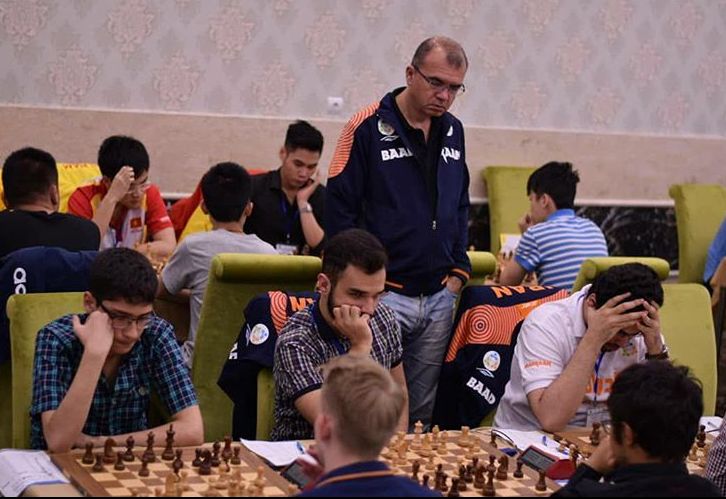
Ivan Sokolov was the coach of Iran team that recently won the Asian Nation's Cup 2018
SS: And what’s the status now? Has it ended?
IS: No, it hasn’t ended. It’s just that they had a few things to sort out. Due to the country’s economic situation, it wasn’t clear on how they were going to send a team to the Olympiad, what their preparation was going to be or what their budget was. At that time it was not even clear if the Asian Teams will take place in Iran. By the time they had everything sorted out and cleared, I had already accepted the job to be a commentator at the Olympiad.
SS: So when you started in 2016, what did you see in the team and what was your main focus on?
IS: Well, it was clear to me that they had great potential. I did, at the time, speak to the federation’s President and told him that they’ve got extremely talented boys but what they don’t realize is that in Alireza Firouzja, they have world champion material.
I also told them that this world championship material will not remain forever. So I suggested them to ask the government for some special sponsorships like Giri got in the Netherlands...Their moment is now, because age always matters. If they let this moment pass, they would miss their chance. He will not be able to achieve what he potentially can.
So far, not much has happened with regard to this proposal. He has training sessions with me just like everyone else. Also when it comes to tournament support, it’s just the same for him like the other boys — not more, not less.
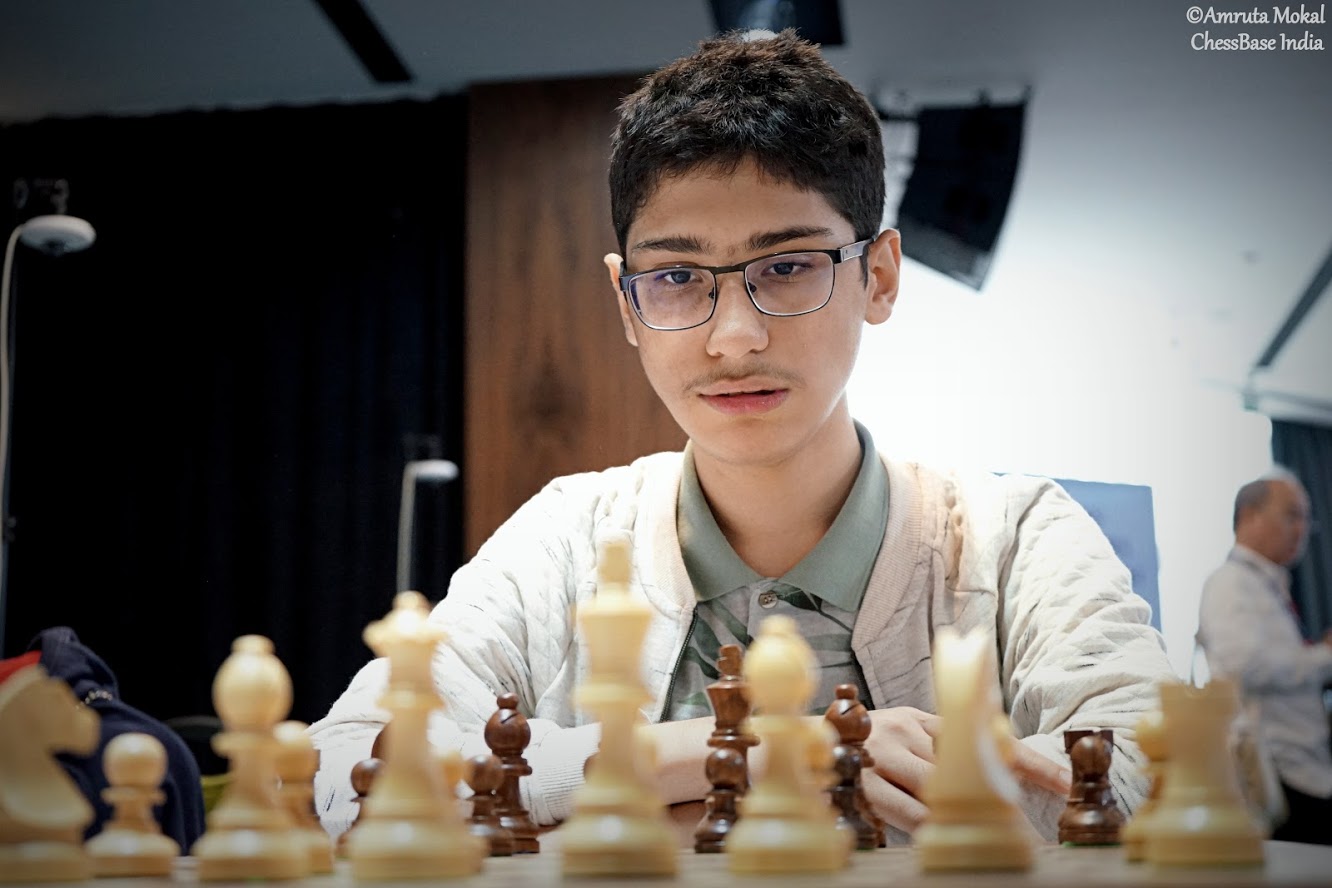
In 15-year-old Alireza Firouzja, Sokolov sees a future World Champion | Photo: Amruta Mokal
SS: But why do you think Firouzja is world championship material? What did you see in him?
IS: I saw young Anand. I and Anand are from the same generation and I can tell that Firouzja has incredible similarities to Anand when he was young.
SS: In what sense?
IS: In the sense that he thinks extremely fast and sometimes that becomes a drawback for him, just like it was in Anand’s case. In those years, Anand was also suffering from this. Sometimes, he would take a decision too quickly but it was obvious to every one of us from this generation that Anand had something which we didn’t.
In the case of Firouzja, I think he has something special in him when it comes to chess. And given his young age, he has the potential to become a world champion. And other players will become very strong players but that is not exactly the same.
SS: But you don’t see him playing as fast as Anand used to. He takes his time, he is calm…
IS: Oh, you’ve never analyzed with him. Trust me, at one point I told him I would cut both of your hands. (laughs)
SS: So he would just make the moves as soon as he saw them?
IS: Yeah, the connection between his brain and his hand is kind of instant.
Firouzja at the World Junior Championship in Turkey, three months ago, analysing with Spanish IM Brian Sebastian Escalante Ramirez
SS: But when you give them a tough position or something, does it ever happen that Alireza comes up with the solution in a flash while the other boys struggle?
IS: Sometimes, not always. Sometimes, he thinks too fast about a problem. I often ask him, ‘If you really think the solution was a two-move combination, do you really believe I would have put that position in front of you?” And sometimes, he is satisfied with the solution too quickly. But this is just the process of maturing as a player.
SS: This is what you worked on.
IS: Yes. But he has to take advantage — actually the entire Iranian Chess Federation has to take advantage — of the moment, of his age. This is, I think, his biggest advantage over Parham (Maghsoodloo). He is simply young; this is the reality.
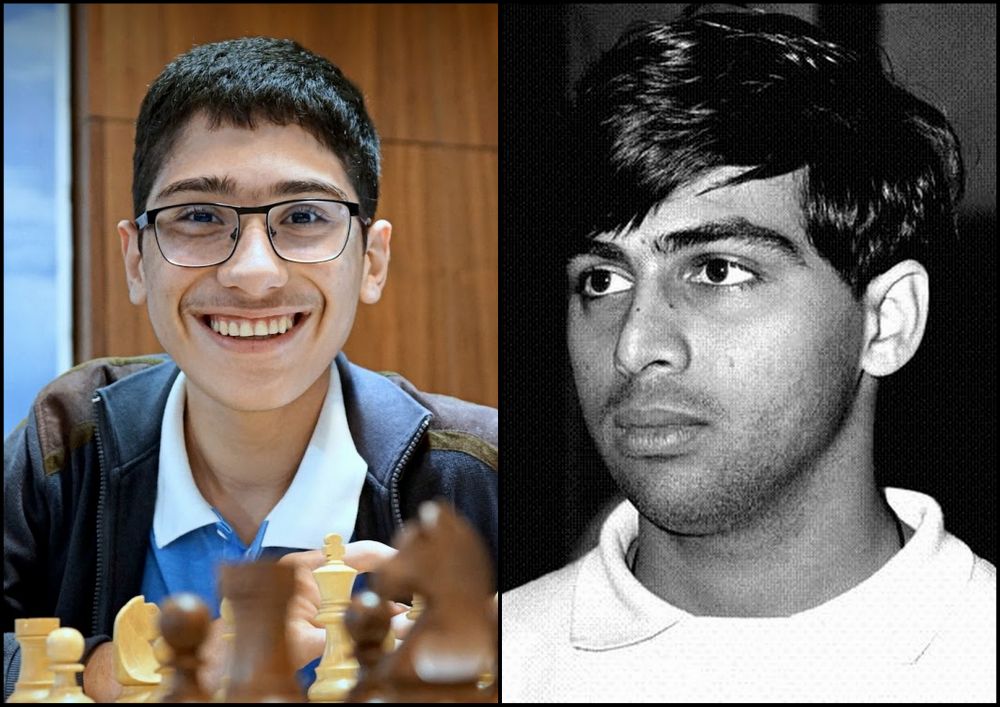
Sokolov played a lot with the young Anand and when training Alireza he can see a lot of similarities!
SS: But Parham is only three years older. Do three years make that big of a difference?
IS: I think three years make a lot more difference these days in comparison to my time. People acquire knowledge quicker, they have computers, information travels fast. I think three years is a lot of time.
SS: But the way Parham is playing here (at the World Juniors 2018), you can say he is not the most accurate player but he is a true fighter. Something like a street fighter, never afraid to take someone on!
IS: When I met Parham for the first time in 2016. He was rated around 2400. We had a tournament in Iran where he was playing against some Chinese guy — Lu Shanglei if I am not mistaken — and he had a position where perhaps only a computer can hold a draw; humans would just lose because the position required several accurate moves to be made at several points. And Parham not only managed to hold, but won that game! I thought this guy is going to be something special. While watching him, I was sitting with Dreev and we both looked at each other amazed at what he had done. We both agreed that he is going to make some very fast progress and that is exactly what he did. He also has a very unusual style of playing. It is difficult to put in words.
SS: If you had to put it in words, how would you describe him?
IS: Well, by his playing style and openings, he reminds me a bit of Vaganian, with the difference that Parham calculates much better.

Maghsoodloo = Vaganian + better calculation!
SS: And what about his defensive skills, how has he developed that?
IS: He is very resourceful. Also when he is analyzing different positions, he is very resourceful. Even when he gets a lousy position, he is very good at looking for chances – he just refuses to die. I think this is maybe an innate talent. It is very difficult to learn this.
SS: Do you think it is his situation, maybe the economic situation of the country or his family that provokes this kind of resourcefulness?
IS: Actually, I think so. It may sound illogical but the difficult economic situation in Iran is helping their chess boom. I do think this is the reason we don’t have so many strong players from western Europe. It’s not because they are less talented but because they are not as interested. Why should they be interested when regular life opportunities provide more chances than the slippery roads of becoming a chess player. In this sense, I think you are right. This economic hardship that they have is helping their chess prosper.
SS: And what about Amin Tabatabaei?
IS: He is also very good. Again, he is a bit older than Firouzja. You may say it is only two years but those years are important. He has made great progress. I started working with him before I came to Iran to coach the team. This was in the beginning of 2016. He was rated about 2430 and, in this short period, he has made massive progress. We are going to see more of him, that is for sure.
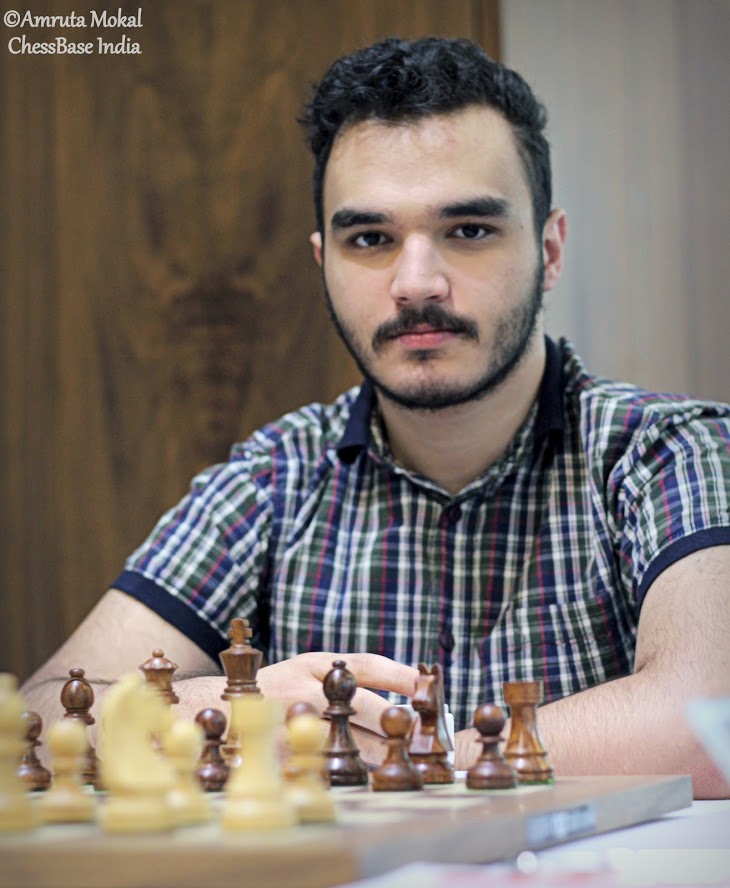
SS: And what do you think is the secret of their confidence? Whenever you see them, they are walking with their chest high and, in comparison to them, the Indians and the Chinese players looked a bit mellowed down.
IS: Yes, this is actually true. Confidence is important. You could see this confidence problem prevented the Indian team from playing well at the Asian Nations Cup 2018. When they had the chance, they couldn’t perform. But after they lost all their chances, the pressure was off them and they began to show their full potential. The biggest problem was that in the important matches, there was such a psychological strain that it was clear that they were underperforming due to psychological reasons and not because of their strength.
SS: And they are all immensely strong players.
IS: Yes, and it was very obvious to me that the whole team, when they were playing against Iran, that they were suffering from psychological problems. I even told my players that India might be strong on paper but the entire team is under pressure, be it Sethuraman, Ganguly, Adhiban, Sasikiran… all of them simply under the pressure could not perform up to their ability.
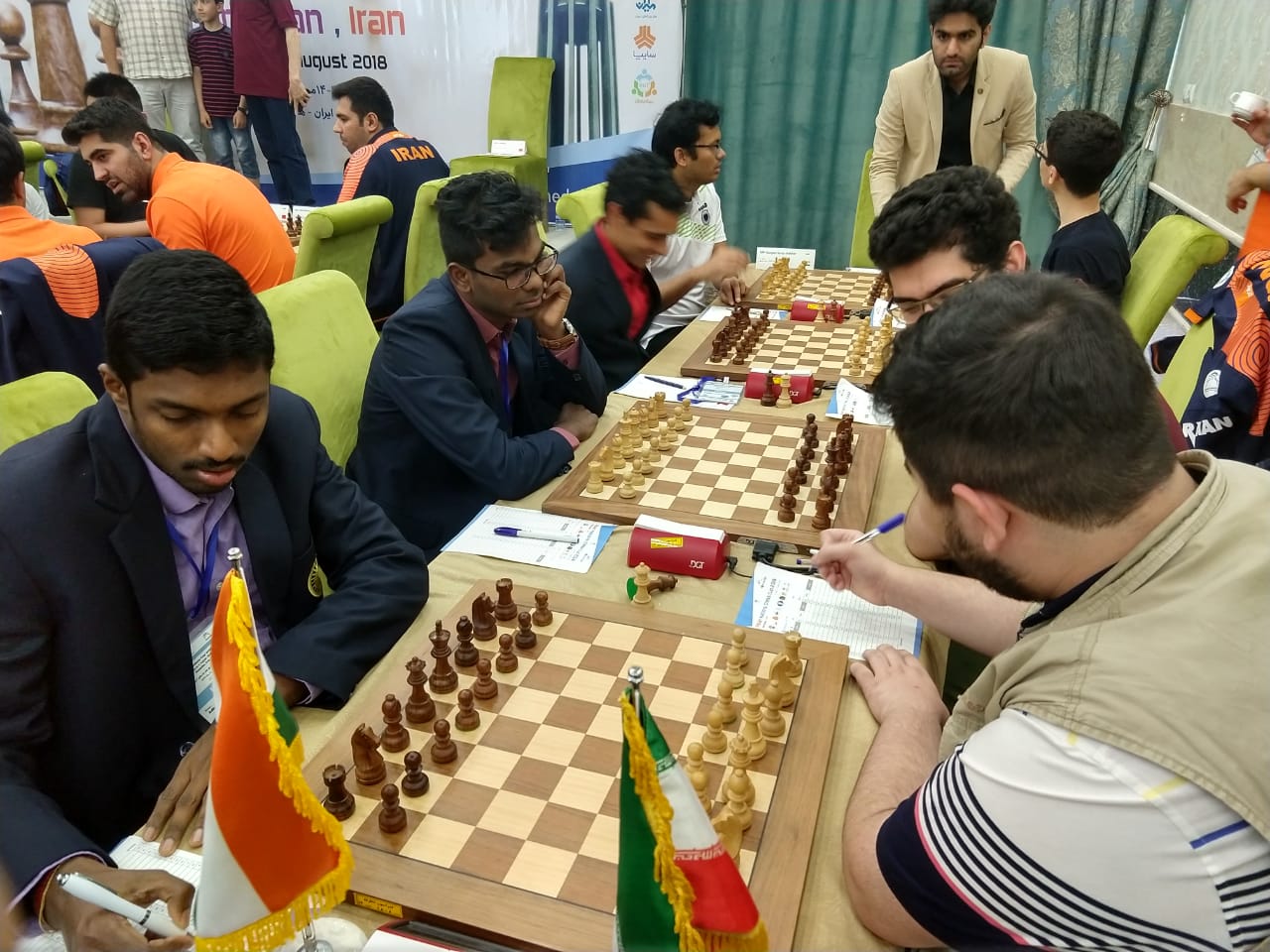
The strong Indian team consisting of Adhiban, Sethuraman, Sasikiran, Ganguly lost to the young Iran team of Maghsoodloo, Pouya, Tabatabaei and Firouzja with a score of 2½:1½. The crucial game was Tabatabaei beating Sasikiran with other three ending in draws
SS: Apart from these three guys – Tabatabaei, Firouzja and Maghsoodloo – is there anyone else who has the capacity to become a very strong player?
At this moment, the three of them are much better than the rest. I even was proposing the federation to prepare three different programs, to simply ask for approvals for three separate programs from the sports ministry for the three of them and then evaluate after one year. That’s because all three of them are very good. I may think that Firouzja is the only one who is world championship material, but I can obviously be wrong. [laughs]
SS: Do you think the government is supporting them enough for them to keep improving?
IS: I think this is good enough, because they are working on their own, but the situation can be better. They were asking me what else they can do and I told them they could play in tournaments where otherwise they would have problems playing, because in Iran they have a big problem converting their Rials into Dollars, if they want to go somewhere. I don’t think any of them even have credit cards. There are a number of practical obstacles in their way.
But next to those practical obstacles, I think, the way for a person to really develop the most of their talent is by hiring different people to learn the best they can. That means you are not going to learn the middle game, Najdorf and endgame from Ivan Sokolov. This is not going to work (laughs)! You have to hire a guy who is good at one thing and another guy for another thing. I was even offering to find them the right guys for the right areas. For me, I am good at a few things and just OK at others.
A version of this interview appeared at ChessBase India. It has been edited for length.